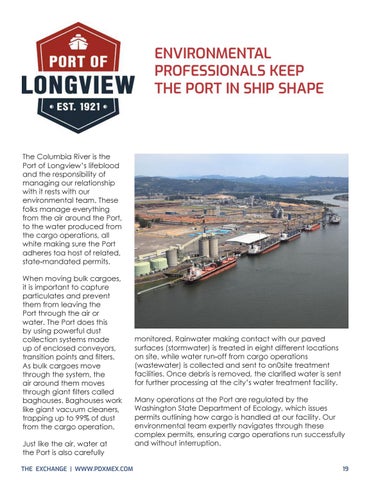PORT OF LONGVIEW
ENVIRONMENTAL PROFESSIONALS KEEP THE PORT IN SHIP SHAPE
The Columbia River is the Port of Longview’s lifeblood and the responsibility of managing our relationship with it rests with our environmental team. These folks manage everything from the air around the Port, to the water produced from the cargo operations, all white making sure the Port adheres toa host of related, state-mandated permits. When moving bulk cargoes, it is important to capture particulates and prevent them from leaving the Port through the air or water. The Port does this by using powerful dust collection systems made up of enclosed conveyors, transition points and filters. As bulk cargoes move through the system, the air around them moves through giant filters called baghouses. Baghouses work like giant vacuum cleaners, trapping up to 99% of dust from the cargo operation. Just like the air, water at the Port is also carefully THE EXCHANGE | WWW.PDXMEX.COM
monitored. Rainwater making contact with our paved surfaces (stormwater) is treated in eight different locations on site, while water run-off from cargo operations (wastewater) is collected and sent to on0site treatment facilities. Once debris is removed, the clarified water is sent for further processing at the city’s water treatment facility. Many operations at the Port are regulated by the Washington State Department of Ecology, which issues permits outlining how cargo is handled at our facility. Our environmental team expertly navigates through these complex permits, ensuring cargo operations run successfully and without interruption. 19















